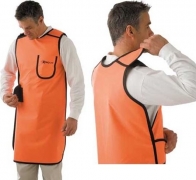During fluoroscopic procedures, a continuous x-ray beam is passed through a specific part of the patient’s body. The beam transmits an image to a monitor so the body part and motions can be easily seen in great detail. Fluoroscopy is used in many types of medical procedures, such as cardiac catheterization, lumbar puncture, biopsies, etc. Medical personnel who are around fluoroscopic work must use appropriate radiation protection and this absolutely includes wearing an x-ray apron.
X-ray aprons can reduce the dose of radiation received by over 90%, depending on the kV settings (energy of x-rays) and the lead equivalency from your apron. For employees working in a high-energy work environment regularly, it may be best to select an x-ray apron with both front and back protection. Scatter radiation can easily reflect off objects in the procedure room. Different procedures may require different levels of radiation, but it’s always best to use the standard level of protection when working around radiation.
Both lead and non-lead aprons can be used for protection during fluoroscopic procedures. The standard level of protection is 0.5 mm Pb lead equivalency. If scatter radiation is an issue in your medical setting, we recommend selecting an apron that can protect both your front and back. For example, the AttenuTech Quickship Radiation Lightweight Lead Flexiback Frontal Apron has lead protection front/back of 0.5 /0.25 mm Pb equivalency. For more specific information pertaining to your medical setting, your radiation safety officer in your facility will be able to provide more detailed information.In addition to x-ray aprons it’s important to keep other body parts protected such as hands, eyes, thyroid, etc. If you have any questions or comments regarding x-ray aprons in fluoroscopic procedures please let us know in the comment box below. We would love to hear what type of personal radiation protection gear you’re wearing in your medical facility!


Leave a Reply